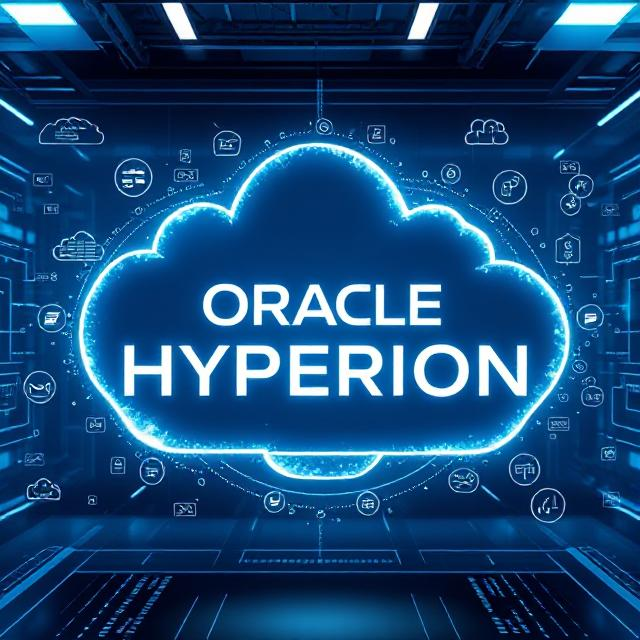Introduction
Oracle Hyperion has long been the cornerstone for financial management in many enterprises, enabling them to streamline budgeting, forecasting, financial consolidation, and reporting. However, with the rapid growth of cloud technologies, Oracle Hyperion has made a significant shift, transitioning from traditional on-premise deployment to a more flexible, cloud-based environment with Oracle Cloud Infrastructure (OCI). This blog will guide you through the journey of Oracle Hyperion, outlining its evolution and the transformative impact of moving to the cloud, with a focus on financial management.

Oracle Hyperion: A Quick Overview
Oracle Hyperion is a suite of integrated applications designed to manage and streamline complex financial processes. The main components include:
| Component | Functionality |
| Oracle Hyperion Planning | Budget creation, forecasting, and financial planning. |
| Oracle Hyperion Financial Management (HFM) | Financial consolidation and reporting. |
| Oracle Hyperion Essbase | Multidimensional database for online analytical processing (OLAP). |
| Oracle Hyperion Reporting & Analysis | Interactive reports and dashboards for financial analysis. |
Challenges of Traditional On-Premise Hyperion Deployment
Historically, Oracle Hyperion was deployed on-premise, which allowed organizations complete control over their hardware, software, and security. However, this model came with several challenges:
- High Maintenance Costs: On-premise solutions required significant resources for hardware, software updates, and infrastructure management.
- Scalability Limitations: Scaling on-premise solutions to meet growing data demands meant expensive hardware upgrades and extended timelines.
- Limited Flexibility: Remote access and collaboration were more challenging, especially for global teams working across different locations.
The Shift to the Cloud: Oracle Hyperion on Oracle Cloud Infrastructure (OCI)

The transition to the cloud offers numerous advantages, enabling organizations to become more agile, cost-effective, and secure. Oracle Hyperion on (Oracle Cloud Infrastructure) OCI is optimized for performance, scalability, and integration. Below is a detailed breakdown of how the cloud revolutionizes financial management:
| Aspect | Traditional On-Premise | Oracle Hyperion on OCI (Cloud) |
| Cost Efficiency | High upfront hardware and software costs, ongoing maintenance | Pay-per-use model, no hardware maintenance, reduced IT overhead |
| Scalability | Difficult and expensive to scale infrastructure | On-demand scaling, seamless capacity expansion |
| Collaboration | Limited, especially for global teams | Real-time access, improved collaboration across geographies |
| Security | Requires in-house management and updates | Oracle-managed security, automatic updates, compliance assurance |
| Integration | Manual, often complex integration with other systems | Seamless integration with Oracle ERP, Oracle EPM Cloud, and third-party systems |
Technical Aspects of Moving Oracle Hyperion to OCI
Moving Oracle Hyperion to (Oracle Cloud Infrastructure) OCI requires careful planning and execution. Below is a breakdown of the key technical components involved:
1. Pre-Migration: Discovery & Assessment
- Discovery: Gather all necessary information regarding the current Hyperion environment (e.g., architecture, customizations, integrations).
- Assessment: Evaluate the scope of migration, understand the current server configurations, and identify any dependencies.
2. Migration: Implementation
- Development Migration: Install and configure Hyperion on OCI, integrate with source/target systems, and test performance.
- User Acceptance Testing (UAT): Validate that the migration process works smoothly in a QA environment before moving to production.
- Production Migration: Migrate Hyperion to OCI, ensuring data validation, performance tuning, and security updates.
3. Post-Migration: Operations & Optimization
- Monitor Performance: Continuously monitor compute resources, data integration, and system performance.
- Hypercare: Transition the migration team to operational teams, providing support for user queries and ensuring month-end and quarter-end activities are handled smoothly.
Advantages for Financial Professionals
Moving to the cloud isn't just about the technology—it's about transforming how financial teams work:
- Streamlined Financial Planning: Automation and cloud tools streamline budgeting and forecasting, freeing up time for strategic decision-making.
- Faster Decision-Making: Real-time data access allows finance teams to make informed, proactive decisions more quickly.
- Improved Collaboration: Cloud-based tools ensure that all stakeholders, regardless of location, are working with up-to-date data and insights.
Challenges and Considerations
While the shift to the cloud brings many benefits, there are challenges to consider:
- Data Migration: Moving large volumes of financial data to the cloud can be complex. It's crucial to ensure that the migration process is well-planned to maintain data integrity.
- Change Management: Employees may need training to adapt to new cloud-based systems and workflows.
- Customization: Some organizations may need to adjust their business processes, as customization options on OCI may differ from the traditional on-premise setup.
Conclusion
The evolution of Oracle Hyperion from on-premise solutions to cloud-based offerings is reshaping the financial management landscape. Organizations now could leverage the scalability, flexibility, and cost savings of the cloud while maintaining the robust functionality they rely on. Oracle Hyperion on OCI not only enhances operational efficiency but also empowers financial teams to make data-driven decisions faster, collaborate seamlessly, and meet global compliance standards with ease.
As Oracle continues to innovate, the future of financial management will be increasingly data-driven, agile, and interconnected, with advanced tools like AI and machine learning paving the way for smarter, more predictive financial insights. To learn more, Check out our blogs on Hyperion!

